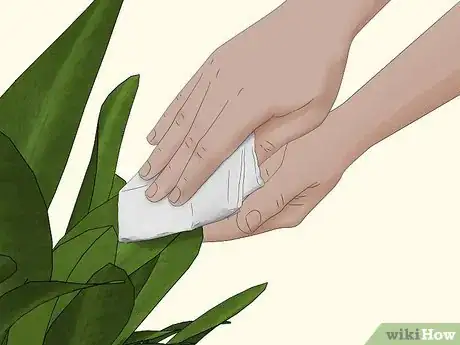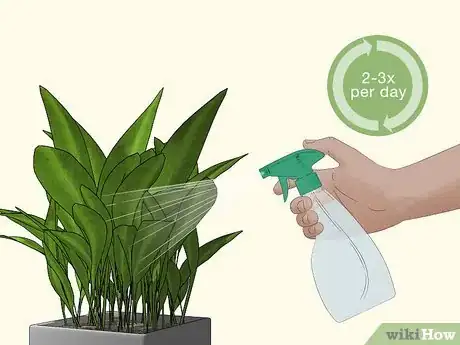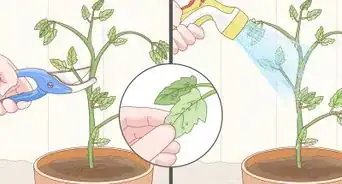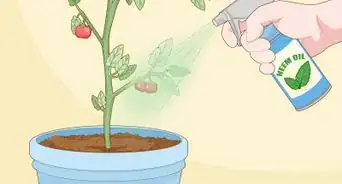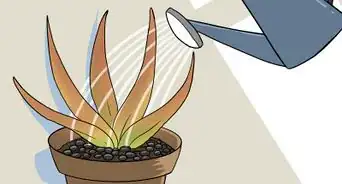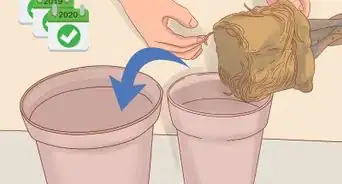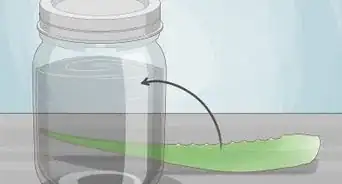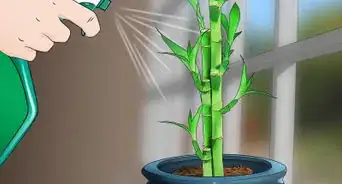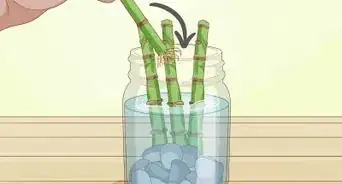This article was co-authored by Chikezie Onyianta. Chikezie Onyianta is a Pest Control Specialist and the Owner of EcoFusion Pest Control, serving communities in New Jersey, Pennsylvania, and New York. With over 5 years of experience, he specializes in pest control in both residential and commercial spaces. A graduate of Essex County College, Chikezie and EcoFusion assist in rodent, roach, and ant pest control as well as bed bug services.
There are 8 references cited in this article, which can be found at the bottom of the page.
wikiHow marks an article as reader-approved once it receives enough positive feedback. In this case, several readers have written to tell us that this article was helpful to them, earning it our reader-approved status.
This article has been viewed 150,888 times.
Spider mites are tiny arachnids that can sometimes be found feeding on the chlorophyll, sap, and other plant fluids from within your plants. When your plants have been infested with spider mites, the leaves will appear speckled and mottled, and contain spots that are white and yellow in color. Spider mites primarily thrive in warm, dry areas in temperatures of at least 85 degrees Fahrenheit (29.44 degrees Celsius) and in humidity levels of less than 60 percent. Spider mites cannot survive in environments that are extremely cold, wet, and humid. To prevent spider mites from infesting your houseplants, you must keep your plants hydrated, moist, and stored in a humid environment.
Steps
-
1Keep your houseplants hydrated. Watering your houseplants as needed on a regular basis will prevent spider mite infestation, since spider mites only thrive on houseplants that are dry.[1]
- Use cold water instead of lukewarm water to water your houseplants. Spider mites will not infest your plants if the temperature is too cold.
-
2Remove dust from your houseplants once per week. This will prevent spider mites from nesting and laying eggs on the dry, dusty leaves; in addition to providing an environment in which existing predator mites can feed on spider mites.[2]
- Depending on the indoor climate and environment in which your houseplants reside, you may need to remove dust as needed, which can be once every few days or once every 2 weeks.
- Dust your houseplants by spraying them with powerful jets of water or use a damp, wet cloth to dust each leaf separately. The method you use may vary depending on the size of your houseplants or where they are located inside your home.
- Place your houseplants in a large sink, bathtub, shower, or outside next to a garden hose.
- Use a powerful jet hose or spray nozzle to spray water on the leaves of your houseplants to remove all the dust.
- Spray and dust on the undersides of leaves, where spider mites will thrive more often to escape direct sunlight.
- If you decide to dust your houseplants with a soft, damp cloth, wipe down each side of each leaf on every houseplant.
Advertisement -
3Create a humid environment for your houseplants.[3]
- Mist your houseplants using a spray bottle of cold water between 2 and 3 times per day.
- If your houseplants reside in pots that sit atop platters or dishes, fill each platter with water to provide extra humidity.
-
4Shade your houseplants from direct sunlight and hot temperatures. Excessive exposure to heat may dry the leaves of your plant and attract spider mites.[4]
- Draw the curtains or close the shades near your plants during the hottest hours of the day and when they are exposed to direct sunlight.
- If your indoor environment does not allow you to provide shade for your houseplants, you can place a humidifier next to any houseplants at risk for spider mites.
-
5Place predatory mites on your houseplants. Certain types of predatory mites will prey and feed on spider mites without harming your plants.[5]
- There are several species of predatory mites you can choose from; however, the most common types of predatory mites are Metaseiulus occidentalis, Phytoseiulus persimilis, and Phytoseiulus longpipes.
- To prevent Metaseiulus occidentalis from dying, you must make sure that the temperature in which your houseplants reside averages between 44 degrees and 89 degrees Fahrenheit (6.66 degrees and 31.66 degrees Celsius).
- Purchase predatory mites from gardening vendors on the Internet or order them by mail from a horticultural website.
- If you do not have Internet access, you may visit your local nursery or gardening store for assistance or recommendations for ordering predatory mites.
Community Q&A
-
QuestionDo spider mites live in soil? Is it best to get rid of infested houseplant soil and replace with fresh soil?
 Community AnswerSpider mites are ubiquitous in nature and can float on air currents using tiny silk threads in a technique called ballooning. The easiest way to deal with spider mites is to sprays the plants with water regularly, and keep the humidity high.
Community AnswerSpider mites are ubiquitous in nature and can float on air currents using tiny silk threads in a technique called ballooning. The easiest way to deal with spider mites is to sprays the plants with water regularly, and keep the humidity high. -
QuestionMy houseplants have bugs that look like tiny cotton balls. How do I get rid of them permanently?
 Community AnswerThese insects are called mealybugs, and are commonly found on houseplants. You can use insecticides or neem-based products to get rid of them.
Community AnswerThese insects are called mealybugs, and are commonly found on houseplants. You can use insecticides or neem-based products to get rid of them. -
QuestionWhat do spider mite eggs look like?
 Community AnswerThey are tiny white eggs. You will need a jeweler's loupe to see them. Remove a leaf that is damaged and take it to a well lit place, then look at the leaf through the loupe. Make sure to quarantine house plants before bringing any kind of plant into your home, and check them before they get the chance to spread.
Community AnswerThey are tiny white eggs. You will need a jeweler's loupe to see them. Remove a leaf that is damaged and take it to a well lit place, then look at the leaf through the loupe. Make sure to quarantine house plants before bringing any kind of plant into your home, and check them before they get the chance to spread.
Things You'll Need
- Hose
- Spray bottle
- Soft cloth
- Spray nozzle attachment
References
- ↑ https://www.apartmenttherapy.com/spider-mites-how-to-save-houseplants-from-them-240805
- ↑ https://extension.umd.edu/hgic/topics/spider-mites-houseplants
- ↑ https://www.rhs.org.uk/advice/profile?pid=190
- ↑ https://www.tipsbulletin.com/how-to-get-rid-of-spider-mites/
- ↑ https://bestplants.com/spider-mites/
- https://www.pests.org/how-to-get-rid-of-spider-mites/
- https://getbusygardening.com/control-spider-mites/
- http://www.unce.unr.edu/publications/files/ho/other/fs9605.pdf

